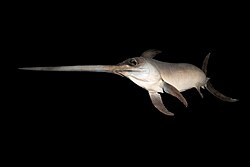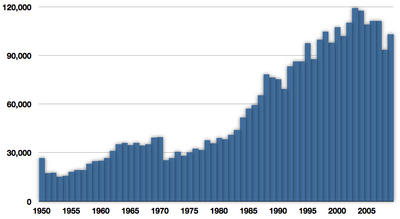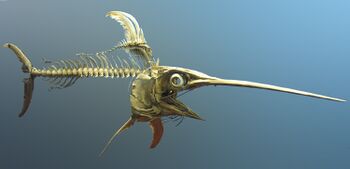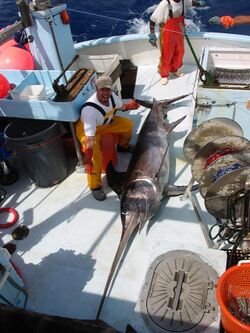Biology:Swordfish
| Swordfish | |
|---|---|

| |
| Scientific classification | |
| Domain: | Eukaryota |
| Kingdom: | Animalia |
| Phylum: | Chordata |
| Class: | Actinopterygii |
| Order: | Istiophoriformes |
| Family: | Xiphiidae Swainson, 1839 |
| Genus: | Xiphias Linnaeus, 1758 |
| Species: | X. gladius
|
| Binomial name | |
| Xiphias gladius | |

| |
| Global distribution of swordfish in blue | |
| Synonyms[3] | |
| |
Swordfish (Xiphias gladius), also known as broadbills[4] in some countries, are large, highly migratory predatory fish characterized by a long, flat, pointed bill. They are a popular sport fish of the billfish category, though elusive. Swordfish are elongated, round-bodied, and lose all teeth and scales by adulthood. These fish are found widely in tropical and temperate parts of the Atlantic, Pacific, and Indian Oceans, and can typically be found from near the surface to a depth of 550 m (1,800 ft), and exceptionally up to depths of 2,234 m.[2] They commonly reach 3 m (10 ft) in length, and the maximum reported is 4.55 m (14 ft 11 in) in length and 650 kg (1,430 lb) in weight.[3][5]
They are the sole member of their family, Xiphiidae.[6]
Taxonomy and etymology
The swordfish is named after its long pointed, flat bill, which resembles a sword. The species name, Xiphias gladius, derives from Greek ξιφίας (xiphias, "swordfish"), itself from ξίφος (xiphos, "sword") and from Latin gladius ("sword").[5] This makes it superficially similar to other billfish such as marlin, but upon examination, their physiology is quite different and they are members of different families.[7]
Several extinct genera are known, such as a large sized Xiphiorhynchus and Aglyptorhynchus.[8] Unlike modern taxa these have equally long lower jaws.[citation needed]
Description
They commonly reach 3 m (10 ft) in length, and the maximum reported is 4.55 m (14 ft 11 in) in length and 682 kg (1,500 lb) in weight.[3][5][9] The International Game Fish Association's all-tackle angling record for a swordfish was a 536 kg (1,182 lb) specimen taken off Chile in 1953.[2] Females are larger than males, and Pacific swordfish reach a greater size than northwest Atlantic and Mediterranean swordfish.[5]
They reach maturity at 4–5 years of age and the maximum age is believed to be at least 9 years.[5] The oldest swordfish found in a recent study were a 16-year-old female and 12-year-old male. Swordfish ages are derived, with difficulty, from annual rings on fin rays rather than otoliths, since their otoliths are small in size.[10]
Temperature regulation
Swordfish are ectothermic animals; however, along with some species of sharks, they have special organs next to their eyes to heat their eyes and brains.[11][page needed] Their eyes are heated to temperatures measured between 10 to 15 °C (18 to 27 °F) above the surrounding water temperature, this heating greatly improves their vision, and consequently improves their ability to catch prey.[12][13]
The swordfish is one of 22 fish, including the marlin, tuna, and some sharks, known to have a mechanism that conserves heat.[12][13]
Behavior and ecology
Movements and feeding
The popular belief of the "sword" being used as a spear is misleading. Their nose is more likely used to slash at its prey to injure the prey animal, to make for an easier catch.[5] The use as an offensive spear in case of dangers against large sharks or animals is under review.
Mainly, the swordfish relies on its great speed and agility in the water to catch its prey. It is no doubt among the fastest fish, but the basis for the frequently quoted speed of 100 km/h (60 mph) is unreliable.[14] Research on related marlin (Istiophorus platypterus) suggest a maximum value of 36 km/h (22 mph) is more likely.[15]
Swordfish are not schooling fish. They swim alone or in very loose aggregations, separated by as much as 10 m (35 ft) from a neighboring swordfish. They are frequently found basking at the surface, airing their first dorsal fin. Boaters report this to be a beautiful sight, as is the powerful jumping for which the species is known. This jumping, also called breaching, may be an effort to dislodge pests, such as remoras or lampreys.[citation needed]
Swordfish prefer water temperatures between 18 and 22 °C (64 and 72 °F),[2] but have the widest tolerance among billfish, and can be found from 5 to 27 °C (41 to 81 °F).[5] This highly migratory species typically moves towards colder regions to feed during the summer.[5] Swordfish feed daily, most often at night, when they rise to surface and near-surface waters in search of smaller fish. During the day, they commonly occur to depths of 550 m (1,800 ft; 300 fathoms) and have exceptionally been recorded as deep as 2,878 m (9,442 ft; 1,574 fathoms).[2] Adults feed on a wide range of pelagic fish, such as mackerel, barracudinas, silver hake, rockfish, herring, and lanternfishes, but they also take demersal fish, squid, and crustaceans.[3][5] In the northwestern Atlantic, a survey based on the stomach content of 168 individuals found 82% had eaten squid and 53% had eaten fish, including gadids, scombrids, butterfish, bluefish, and sand lance.[16] Large prey are typically slashed with the sword, while small are swallowed whole.[5]
Threats and parasites
Almost 50 species of parasites have been documented in swordfish. In addition to remoras, lampreys, and cookiecutter sharks, this includes a wide range of invertebrates, such as tapeworms, roundworms, Myxozoans and copepods.[5][17] A comparison of the parasites of swordfish in the Atlantic and in the Mediterranean indicated that some parasites, particularly Anisakis spp. larvae identified by genetic markers, could be used as biological tags and support the existence of a Mediterranean swordfish stock.[18]
Fully adult swordfish have few natural predators. Among marine mammals, killer whales sometimes prey on adult swordfish.[5] The shortfin mako, an exceptionally fast species of shark, sometimes take on swordfish; dead or dying shortfin makos have been found with broken-off swords in their heads, revealing the danger of this type of prey.[19] Juvenile swordfish are far more vulnerable to predation, and are eaten by a wide range of predatory fish.[5][20] Intensive fishery may be driving swordfishes and sharks into harder competition for reduced amounts of prey and therefore pitting them to fight more.[20]
Human fishery is a major predator of swordfishes. The annual reported catch in 2019 of the North Atlantic swordfish amounted to a total of 1.3 million kilograms (2.9 million pounds).[21]
Breeding
In the North Pacific, batch spawning mainly occurs in water warmer than 24 °C (75 °F) during the spring and summer, and year-round in the equatorial Pacific.[2] In the North Atlantic, spawning is known from the Sargasso Sea,[22] and in water warmer than 23 °C (73 °F) and less than 75 m (246 ft; 41 fathoms) deep.[2] Spawning occurs from November to February in the South Atlantic off southern Brazil .[2] Spawning is year-round in the Caribbean Sea and other warm regions of the west Atlantic.[5]
Large females can carry more eggs than small females, and between 1 million to 29 million eggs have been recorded.[2] The pelagic eggs measure 1.6–1.8 mm (1⁄16–5⁄64 in) in diameter and 2 1⁄2 days after fertilization, the embryonic development occurs.[22][5] The surface-living and unique-looking larvae are 4 mm (5⁄32 in) long at hatching.[3][5] The bill is evident when the larvae reach 1 cm (3⁄8 in) in length.[3]
Fisheries


Swordfish were harvested by a variety of methods at small scale (notably harpoon fishing) until the global expansion of long-line fishing. They have been fished widely since ancient times in places such as the Strait of Messina, where they are still fished with traditional wooden boats called feluccas and are part of the cuisine in that area.[24][25][26]
Swordfish are vigorous, powerful fighters. Although no unprovoked attacks on humans have been reported, swordfish can be very dangerous when harpooned. They have run their swords through the planking of small boats when hurt. In 2015, a Hawaiian fisherman was killed by a swordfish after attempting to spear the animal.[27]
Recreational fishing
Recreational fishing has developed a subspecialty called swordfishing. Because of a ban on long-lining along many parts of seashore, swordfish populations are showing signs of recovery from the overfishing caused by long-lining along the coast.
Various ways are used to fish for swordfish, but the most common method is deep-drop fishing, since swordfish spend most daylight hours very deep, in the deep scattering layer. The boat is allowed to drift to present a more natural bait. Swordfishing requires strong fishing rods and reels, as swordfish can become quite large, and it is not uncommon to use 2.5 kg (5 lb) or more of weight to get the baits deep enough during the day, up to 460 m (1,500 ft) is common.[28] Night fishing baits are usually fished much shallower, often less than 90 m (300 ft; 50 fathoms). Standard baits are whole mackerel, herring, mullet, bonito, or squid; one can also use live bait. Imitation squids and other imitation fish lures can also be used, and specialized lures made specifically for swordfishing often have battery-powered or glow lights. Even baits are typically presented using glow sticks or specialized deepwater-proof battery operated lights.
As food
Swordfish are classified as oily fish.[29] Many sources, including the United States Food and Drug Administration, warn about potential toxicity from high levels of methylmercury in swordfish.[30][31] The FDA recommends that young children, pregnant women, and women of child-bearing age not eat swordfish.[32]
The flesh of some swordfish can acquire an orange tint, reportedly from their diet of shrimp or other prey. Such fish are sold as "pumpkin swordfish", and command a premium over their whitish counterparts.[citation needed]
Swordfish is a particularly popular fish for cooking. Since swordfish are large, meat is usually sold as steaks, which are often grilled. Swordfish meat is relatively firm, and can be cooked in ways more fragile types of fish cannot (such as over a grill on skewers). The color of the flesh varies by diet, with fish caught on the East Coast of North America often being rosier.
Kashrut
A dispute exists as to whether swordfish should be considered a kosher fish according to the laws of kashrut. Standard Orthodox opinion is that swordfish is not kosher, while Conservative Judaism does consider swordfish kosher. All kosher fish must have both fins and scales. The Talmud and the Tosefta are believed by some to present swordfish ("achsaftias") as an example of a kosher fish without scales because swordfish are born with scales they later shed once attaining a length of about 1 meter. The 17th-century Turkish Sephardi halakhic authority Rabbi Chaim ben Yisrael Benvenisti wrote that "It is a widespread custom among all Jews to eat the fish with the sword, known in vernacular as fishei espada, even though it does not have any scales. Because it is said that when it comes out of the water, due to its anger, it shakes and throws off its scales." A 1933 list of kosher fish published by the Agudas HaRabbonim includes swordfish. The following year, Rabbi Yosef Kanowitz published the same list of kosher fish with swordfish still included. Swordfish was widely considered kosher by halakhic authorities until the 1950s. Orthodox opinion began to shift in 1951, when Rabbi Moshe Tendler examined swordfish and decided it was not kosher due to the lack of scales. Tendler's opinion provoked strong debate among halakhic authorities during the 1960s.[33][34] Among Mediterranean Jews there was a longstanding minhag of considering swordfish kosher. Swordfish was and possibly still is consumed by Jews in Italy, Turkey, Gibraltar, Morocco, Tunisia, and England. Due to Tendler's opinion, swordfish are generally not considered kosher by Orthodox Jews in the United States and Israel.[35]
Conservation status
In 1998, the US Natural Resources Defense Council and SeaWeb hired Fenton Communications to conduct an advertising campaign to promote their assertion that the swordfish population was in danger due to its popularity as a restaurant entree.[36]
The resulting "Give Swordfish a Break" promotion was wildly successful, with 750 prominent US chefs agreeing to remove North Atlantic swordfish from their menus, and also persuaded many supermarkets and consumers across the country.
The advertising campaign was repeated by the national media in hundreds of print and broadcast stories, as well as extensive regional coverage. It earned the Silver Anvil award from the Public Relations Society of America, as well as Time magazine's award for the top five environmental stories of 1998.
Subsequently, the US National Marine Fisheries Service proposed a swordfish protection plan that incorporated the campaign's policy suggestions. Then-US President Bill Clinton called for a ban on the sale and import of swordfish and in a landmark decision by the federal government, 343,600 km2 (132,670 sq mi) of the Atlantic Ocean were placed off-limits to fishing as recommended by the sponsors.
In the North Atlantic, the swordfish stock is fully rebuilt, with biomass estimates currently 5% above the target level.[37] No robust stock assessments for swordfish in the northwestern Pacific or South Atlantic have been made, and data concerning stock status in these regions are lacking. These stocks are considered unknown and a moderate conservation concern. The southwestern Pacific stock is a moderate concern due to model uncertainty, increasing catches, and declining catch per unit effort. Overfishing is likely occurring in the Indian Ocean, and fishing mortality exceeds the maximum recommended level in the Mediterranean, thus these stocks are considered of high conservation concern.[38]
In 2010, Greenpeace International added the swordfish to its seafood red list.[39]
Extinct
In culture
- The swordfish (Xiphias) has been used by astronomers as another name for the constellation of Dorado.[citation needed]
References
- ↑ Fierstine, Harry L. (1990). "A paleontological review of three billfish families (Istiophoridae, Xiphiidae, and Xiphiorhynchidae)". Biological Sciences: 11. https://core.ac.uk/download/pdf/19137929.pdf.
- ↑ Jump up to: 2.0 2.1 2.2 2.3 2.4 2.5 2.6 2.7 2.8 Collette, B.B; Di Natale, A.; Fox, W.; Graves, J.; Juan Jorda, M.; Pohlot, B.; Restrepo, V.; Schratwieser, J. (2022). "Xiphias gladius". IUCN Red List of Threatened Species 2022. doi:10.2305/IUCN.UK.2022-1.RLTS.T23148A46625751.en. https://www.iucnredlist.org/species/23148/46625751. Retrieved 14 October 2022.
- ↑ Jump up to: 3.0 3.1 3.2 3.3 3.4 3.5 Froese, Rainer and Pauly, Daniel, eds. (2018). "Xiphias gladius" in FishBase. February 2018 version.
- ↑ Grey, Zane (2000). Tales of Swordfish and Tuna. Lanham, Maryland and New York, New York, USA: The Derrydale Press. p. 107. ISBN 9781493048809.
- ↑ Jump up to: 5.00 5.01 5.02 5.03 5.04 5.05 5.06 5.07 5.08 5.09 5.10 5.11 5.12 5.13 5.14 5.15 Gardieff, S.. "Swordfish". Florida Museum of Natural History. http://www.flmnh.ufl.edu/fish/Gallery/Descript/Swordfish/Swordfish.html.
- ↑ Froese, Rainer, and Daniel Pauly, eds. (2011). "Xiphiidae" in FishBase. December 2011 version.
- ↑ Pepperell, J. 2010. Fishes of the Open Ocean: A Natural History and Illustrated Guide. ISBN:978-0-226-65539-0
- ↑ Fierstine, Harry L. (2006). "Fossil History of Billfishes (Xiphioidei)". Bulletin of Marine Science.
- ↑ Flindt, Rainer (21 December 2006) (in en). Amazing Numbers in Biology. Springer Science & Business Media. pp. 12. ISBN 978-3-540-30147-9. https://books.google.com/books?id=9t7Tht1kf88C.
- ↑ Marsh, Jesse; Stiles, Margot (2007). "Seafood Watch, Seafood Report, Monterey Bay Aquarium". http://safinacenter.org/documents/2014/06/swordfish-seafood-watch-species-report.pdf.
- ↑ Sherwood, Lauralee; Klandorf, Hillar; Yancey, Paul. Animal Physiology: From Genes to Organisms (2nd ed.). Cengage Learning. ISBN 9781133784579.
- ↑ Jump up to: 12.0 12.1 Fritsches, K. A.; Brill, R. W.; Warrant, E. J. (January 2005). "Warm eyes provide superior vision in swordfishes". Current Biology 15 (1): 55–58. doi:10.1016/j.cub.2004.12.064. PMID 15649365.
- ↑ Jump up to: 13.0 13.1 Hopkin, Michael (January 2005). "Swordfish heat their eyes for better vision". Nature. doi:10.1038/news050110-2. https://www.nature.com/articles/news050110-2.
- ↑ "Haulin' Bass". ReefQuest Centre for Shark Research. http://www.elasmo-research.org/education/topics/r_haulin'_bass.htm. "The 60 mph figure listed for the swordfish is based on a corrupted version of calculations made by Sir James Gray to estimate the impact speed necessary for a hypothetical 600 lb [270 kg] swordfish to embed its sword 3 feet [90 cm] in the timbers of ships, as has been known to occur; the figure seems to have entered the literature without question."
- ↑ Svendsen, Morten B. S.; Domenici, Paolo; Marras, Stefano; Krause, Jens; Boswell, Kevin M.; Rodriguez-Pinto, Ivan; Wilson, Alexander D. M.; Kurvers, Ralf H. J. M. et al. (2016-10-15). "Maximum swimming speeds of sailfish and three other large marine predatory fish species based on muscle contraction time and stride length: a myth revisited" (in en). Biology Open 5 (10): 1415–1419. doi:10.1242/bio.019919. ISSN 2046-6390. PMID 27543056.
- ↑ Stillwell; Kohler (1985). "Food and feeding ecology of the swordfish Xiphias gladius in the western North Atlantic Ocean with estimates of daily ration". Mar. Ecol. Prog. Ser. 22: 239–241. doi:10.3354/meps022239. Bibcode: 1985MEPS...22..239S.
- ↑ Bolin, Jessica A.; Cummins, Scott F.; Mitu, Shahida A.; Schoeman, David S.; Evans, Karen J.; Scales, Kylie L. (2021-06-11). "First report of Kudoa thunni and Kudoa musculoliquefaciens affecting the quality of commercially harvested yellowfin tuna and broadbill swordfish in Eastern Australia" (in en). Parasitology Research 120 (7): 2493–2503. doi:10.1007/s00436-021-07206-8. ISSN 1432-1955. PMID 34115215. https://doi.org/10.1007/s00436-021-07206-8.
- ↑ Mattiucci, S.; Garcia, A.; Cipriani, P.; Santos, M. N.; Nascetti, G.; Cimmaruta, R. (2014). "Metazoan parasite infection in the swordfish, Xiphias gladius, from the Mediterranean Sea and comparison with Atlantic populations: implications for its stock characterization". Parasite 21: 35. doi:10.1051/parasite/2014036. PMID 25057787.
- ↑ The Shark Trust. "Shortfin mako". http://sharks-med.netfirms.com/med/mako.htm.
- ↑ Jump up to: 20.0 20.1 Sokol, Joshua (27 October 2020). "Sharks Wash up on Beaches, Stabbed by Swordfish". The New York Times. https://www.nytimes.com/2020/10/27/science/swordfish-stabbing-sharks.html.
- ↑ "North Atlantic Swordfish | FishWatch". https://www.fishwatch.gov/profiles/north-atlantic-swordfish?_ga=2.62064620.1145261843.1620987530-663530379.1620987530.
- ↑ Jump up to: 22.0 22.1 Froese, Rainer and Pauly, Daniel, eds. (2011). "Xiphias gladius" in FishBase. December 2011 version.
- ↑ "Aquatic species: Xiphias gladius (Linnaeus, 1758)". Food and Agriculture Organization. https://www.fao.org/fishery/en/aqspecies/2503/en.
- ↑ "La Pesca del Pescespada". http://nuke.prolocobagnara.it/BagnaraCalabra/Storia/LaPesca/LaPescadelPescespada/tabid/495/Default.aspx.
- ↑ "La pesca del pesce spada". http://www.biologiamarina.eu/PesceSpada.html.
- ↑ "La tecnica per la pesca del pescespada e la "Feluca" - Ganzirri, il Peloro e lo Stretto di Messina". https://www.ganzirri.it/spip.php?article9.
- ↑ Preuss, Andreas; Marco, Tony (2015-06-01). "Swordfish kills fisherman in Hawaii". CNN.com. http://edition.cnn.com/2015/05/30/us/hawaii-swordfish-kills-fisherman.
- ↑ "Daytime Swordfish Tactics That Work Like a Charm". FishingBooker.com. 2018-10-13. https://fishingbooker.com/blog/proven-daytime-swordfish-tactics.
- ↑ "What's an oily fish?". Food Standards Agency. 24 June 2004. http://www.food.gov.uk/news/newsarchive/2004/jun/oilyfishdefinition.
- ↑ FDA (1990–2010). "Mercury Levels in Commercial Fish and Shellfish". https://www.fda.gov/food/foodsafety/product-specificinformation/seafood/foodbornepathogenscontaminants/methylmercury/ucm115644.htm.
- ↑ EPA. "What you need to know about mercury in fish and shellfish". http://www.epa.gov/waterscience/fishadvice/advice.html#isthere.
- ↑ FDA (2 July 2019). "Advice About Eating Fish". FDA. https://www.fda.gov/media/102331/download.
- ↑ "Swordfish: The Fish of Legends". The Biblical Museum of Natural History. https://www.biblicalnaturalhistory.org/post/swordfish. Retrieved 2023-04-08.
- ↑ "Is Swordfish Kosher?". https://www.chabad.org/library/article_cdo/aid/4660913/jewish/Is-Swordfish-Kosher.htm. Retrieved 2023-04-08.
- ↑ "The Turning of the Tide: The Kashrut Tale of the Swordfish". Bar-Ilan University. https://static1.squarespace.com/static/54694fa6e4b0eaec4530f99d/t/5a8dd6a4f9619a6fc230f2a0/1519244970946/Zivitofsky+-+Kashrus+of+the+swordfish.pdf. Retrieved 2023-04-08.
- ↑ "Swordfish". Fenton Communications. http://www.fenton.com/pages/3_ourwork/4_casestudies/environment/swordfish.htm.
- ↑ "Species directory: North Atlantic Swordfish". NOAA.gov. 28 December 2022. https://www.fisheries.noaa.gov/species/north-atlantic-swordfish.
- ↑ "Seafood Watch – Seafood Report – Swordfish". Monterey Bay Aquarium. http://www.mbayaq.org/cr/cr_seafoodwatch/content/media/MBA_SeafoodWatch_SwordfishReport.pdf.
- ↑ "Greenpeace International Seafood Red List". October 2010. http://www.greenpeace.org/international/PageFiles/173748/Oceans_Advocates.pdf.
Further reading
- Richard Ellis (2013). Swordfish: A Biography of the Ocean Gladiator. University of Chicago Press. ISBN 978-0226922904.
External links
Wikidata ☰ Q164327 entry
 |












